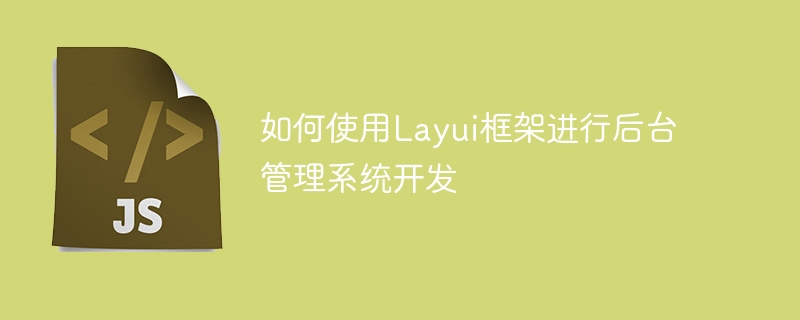

Layui is a lightweight front-end UI framework, suitable for quickly building back-end management systems. This article will introduce how to use the Layui framework for backend management system development and provide specific code examples.
1. Environment preparation
First, make sure you have installed the latest version of the layui library. You can download and import the corresponding files from the Layui official website. In your project, you need to introduce the two files layui.all.js and layui.all.css.
2. Page structure
When using the Layui framework to develop a backend management system, it usually consists of multiple pages. We can use the layout module provided by Layui to implement the overall structure of the page.
<!-- 头部内容 -->
<!-- 侧边栏内容 -->
<!-- 主体内容区域 -->
< /div>
Code explanation:
3. Using modules
Layui provides a wealth of modules, such as forms, tables, pop-up windows, etc., which can easily implement various functions. Below, we'll introduce some commonly used modules and how to use them.
3.1 Form module
The form module is a necessary module for developing backend management systems. Layui provides a series of form elements and validation rules that can easily build form pages.
layui.use('form', function(){
var form = layui.form;
// Form submission event
form.on('submit(formDemo )', function(data){
layer.msg(JSON.stringify(data.field)); return false;
});
// Form verification
form.verify({
username: function(value, item){ // value:表单的值、item:表单的DOM对象
if(!/^[w]{6,12}$/.test(value)){
return '用户名必须由6到12位的字母、数字、下划线组成';
}
},
password: [
/^[S]{6,12}$/,
'密码必须由6到12位的非空白字符组成'
]});
} );
Code explanation:
3.2 Table module
The table module can be used to display data and provide search, paging, sorting and other functions.
layui.use('table', function(){
var table = layui.table;
// Render table
table.render({
elem: '#tableDemo', // 指定表格容器
url: '/api/data', // 请求数据的接口
page: true, // 开启分页
cols: [[ // 表头
{field: 'id', title: 'ID', sort: true},
{field: 'username', title: '用户名'},
{field: 'email', title: '邮箱'}
]]});
});
Code explanation:
4. Summary
Using the Layui framework for backend management system development can quickly build an interface with a good user experience. This article introduces the basic page structure and common modules using Layui, and provides corresponding code examples. Through learning and practice, I believe you will be able to skillfully apply the Layui framework to develop a high-quality backend management system.
The above is the detailed content of How to use the Layui framework for backend management system development. For more information, please follow other related articles on the PHP Chinese website!